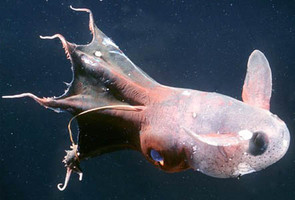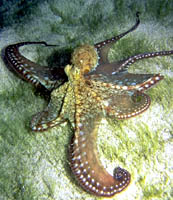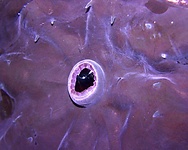Octopodiformes
Vampire Squid and Octopods
Richard E. Young and Michael Vecchione- Octopoda Leach, 1818
- Vampyromorpha Robson, 1929
Introduction
The Octopodiformes consists of the Octopoda which contains over 200 species and the Vampyromorpha which contains a single species. The latter is a phylogenetic relict.
Characteristics
- Arms
- True arms II modified or absent.
- True arms IV unmodified.
- Suckers radially symmetrical.
- Horny rings in suckers absent.
- Functional arms IV united by web (absent in some argonautoids).
- Buccal crown
- Buccal crown absent.
- Buccal crown absent.
- Head
- Outer statocyst capsule present.
- Superior buccal lobes adjacent (fused at edges) or completely fused to posterior buccal lobes.
- Inferior frontal lobe system of brain present or insepient.
- Photosensitive vesicles
- Lie outside of cephalic cartilage: dorsal to funnel (Vampyromorpha) or on stellate ganglia in mantle cavity (Octopoda).
- Lie outside of cephalic cartilage: dorsal to funnel (Vampyromorpha) or on stellate ganglia in mantle cavity (Octopoda).
- Fins
- When present, with cartilagenous axial support (only in juvenile fin of Vampyroteuthis).
- When present, with cartilagenous axial support (only in juvenile fin of Vampyroteuthis).
- Shell
- Shell a gladius, cartilage-like fin support, pair of stylets, or absent.
- Shell a gladius, cartilage-like fin support, pair of stylets, or absent.
- Viscera
- Nidamental glands absent.
- Crop usually present.
- Oviducal glands radially symmetrical.
- Digestive gland duct appendages lie "outside" nephridial coelom.
- Nephridial coeloms separate.
Origin of the Octopoda

Drawing modified from Young, Vecchione and Donovan, 1999.
Naef (1923) felt that the origin of the Octopoda would "forever be obscure." But Naef was unaware of the significance of Vampyroteuthis which was believed to be a cirrate octopod at the time. We now know that the Vampyromorpha is the sister group of the Octopoda and that Vampyroteuthis provides telling clues to the origin of the octopods. Young, et al. (1999) suggest two possible methods for this origin as illustrated here. In one (benthic route) the pelagic ancestor becomes benthic in a horizontal attitude (similar to the sepiolids today) and subsequently the arms and mouth rotate under the head. In the other alternative (pelagic route) the pelagic ancestor develops an "oral" orientation (i.e. laterally spread arms) here pictured with the oral end downward (as in octopods today) and subsequently becomes benthic with the oral end down.
Evidence for the latter route is found in the structure of the brain. Octopods have a series of lobes in the brain, the inferior frontal lobe system, that is derived from the posterior buccal lobe. These lobes process complex chemotactile information from the arms. Vampyroteuthis has an "insipient" inferior frontal lobe system (J. Young, 1977). This bathypelagic animal apparently has a relatively advanced system for processing chemotactile information from the arms, one that surpasses that of shallow-living benthic decapods. Apparently Vampyroteuthis uses its arms in an unusual manner. Young, et al. (1999) suggest that like its immediate ancestor (a "pre-octopod"), associates with pelagic jellyfish or tunicates and uses its arms and suckers to adhere to and/or explore the surfaces of these gelatinous animals. That is, it has an oral orientation for contact with surfaces. The pre-octopod, then was pre-adapted for settling on the ocean floor in an oral-end down configuration. This oral orientation enabled octopods to become the effective crawling animals that most are today. However the manner in which Vampyroteuthis actually uses its arms and its possible association with gelatinous animals has yet to be demonstrated.
Young, et al. (1999) argue, therefore, that the benthic habitat was the primitive one within the Octopoda and that pelagic species, which comprise nine of the eleven octopod families, are secondarily pelagic. In the Cirrates, these authors point out the compaction of viscera, loss of jet propulsion, presence of a fully-formed inferior frontal lobe system, single oviduct, fusion of the head and mantle and reduction of the shell as evidence of a quasi-benthic ancestry. In the Incirrates, they point to the presence of corneas (or their remnants), absence of shell, fins and cirri, fully formed inferior frontal lobe system, probably stalked chorions and brooding as evidence of a fully-benthic ancestry.
Discussion of Phylogenetic Relationships
J. Z. Young (1989), on the basis of anatomical differences, removed the Cirrata from its traditional place in the Octopoda and put it in its own order, Cirroctopodida. Young and Vecchione (1996), however, using cladistic analyses demonstrated that the inclusion of the Cirrata and Incirrata in the Octopoda is justified. That is, the order Octopoda, including the suborders Cirrata and Incirrata is a monophyletic group. This conclusion was more recently strengthened by the inclusion of additional characters in the analyses (Young & Vecchione, 2002).
Nomenclature
A variety of names have been proposed for this group (e.g., Octobrachia, Fiorini, 1981; Octopodiformes, Berthold and Engeser, 1987; Vampyromorphoidea, Engeser and Bandel, 1988; Vampyropoda, Boletzky, 1992). Young, et al.(1999) concluded that Octopodiformes was the most appropriate.
References
Berthold, T. and T. Engeser (1987). Phylogenetic analysis and systematization of the Cephalopoda (Mollusca). Verh. Naturwiss. Ver. Hamburg, 29: 187-220.
Boletzky, S. v. 1992. Evolutionary aspects of development, life style, and reproductive mode in incirrate octopods (Mollusca, Cephalopoda). Revue suisse Zool. 99(4):755-770.
Engeser, T. and K. Bandel (1988). Phylogenetic classification of coleoid cephalopods. In: Wiedmann, J. and Kullmann, J. (Eds.), Cephalopods. Present and past. p105-115. Stuttgart
Fioroni, P. 1981. Die Sonderstellung der Sepioliden, ein Vergleich der Ordnungen der rezenten Cephalopoden. Zool. Jb. Syst., 108: 178-228.
Young, J. Z. 1989. The angular acceleration receptor system of diverse cephalopods. Phil. Trans. R. Soc. Lond. B 325: 189-238.
Young, R. E. and M. Vecchione. (2002). Evolution of the gills in the Octopodiformes. Bull. Mar. Sci., 71:1003-1018.
Young, R. E., M. Vecchione and D. Donovan. 1999. The evolution of coleoid cephalopods and their present biodiversity and ecology. South African Jour. Mar. Sci. (in press).
Title Illustrations

| Scientific Name | Vampyroteuthis infernalis |
|---|---|
| Location | San Clemente Basin off Southern California |
| Comments | Photographed in plankton kreisel aboard the R/V NEW HORIZON. Captured at 700 m depth. |
| Size | 25 cm total length |
| Copyright | © 1999 Brad Seibel |
About This Page
Richard E. Young

University of Hawaii, Honolulu, HI, USA

National Museum of Natural History, Washington, D. C. , USA
Page copyright © 1999 Richard E. Young and
 Page: Tree of Life
Octopodiformes . Vampire Squid and Octopods.
Authored by
Richard E. Young and Michael Vecchione.
The TEXT of this page is licensed under the
Creative Commons Attribution-NonCommercial License - Version 3.0. Note that images and other media
featured on this page are each governed by their own license, and they may or may not be available
for reuse. Click on an image or a media link to access the media data window, which provides the
relevant licensing information. For the general terms and conditions of ToL material reuse and
redistribution, please see the Tree of Life Copyright
Policies.
Page: Tree of Life
Octopodiformes . Vampire Squid and Octopods.
Authored by
Richard E. Young and Michael Vecchione.
The TEXT of this page is licensed under the
Creative Commons Attribution-NonCommercial License - Version 3.0. Note that images and other media
featured on this page are each governed by their own license, and they may or may not be available
for reuse. Click on an image or a media link to access the media data window, which provides the
relevant licensing information. For the general terms and conditions of ToL material reuse and
redistribution, please see the Tree of Life Copyright
Policies.
- Content changed 21 April 2008
Citing this page:
Young, Richard E. and Vecchione, Michael. 2008. Octopodiformes . Vampire Squid and Octopods. Version 21 April 2008 (under construction). http://tolweb.org/Octopodiformes/19405/2008.04.21 in The Tree of Life Web Project, http://tolweb.org/











 Go to quick links
Go to quick search
Go to navigation for this section of the ToL site
Go to detailed links for the ToL site
Go to quick links
Go to quick search
Go to navigation for this section of the ToL site
Go to detailed links for the ToL site